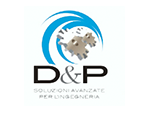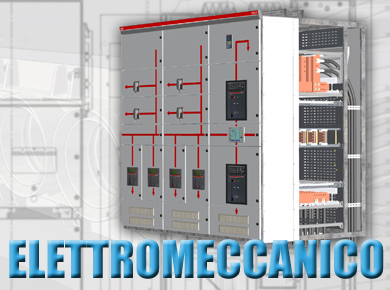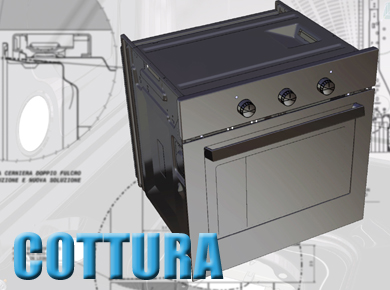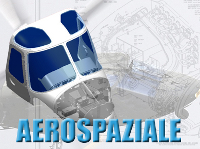AEROSPACE
Strong with a proven experience in the D & P industry, it is able to offer its customers:
- Analysis of "Wiring Diagrams"
- Realization of standard components
- Preliminary layout studies
- Clipping installation and cable assy installation
- Modeling wiring
- Implementation of wiring harnesses
- Complete Kits Management
- Complete management of variants
- Realization of "SOURCE CONTROL DRAWING"
- RDP Manager "Request for Structural Predispositions"
Appliance
Since its inception, D & P has partnered with leading Italian and European companies in the various household appliance and community care industries (Indesit Company, Electrolux, Amica, Merloni Projects, Candy, Omniwash)
D & P is able to offer specific skills for the following products:
- Refrigeration
- Cooking
- washing
- Dishwasher
- Dishwasher for community
D & P follows all the phases of the project:
- Feasibility Analysis
- Definition of technical specification
- Definition of the preliminary project
- Design of aesthetic components design
- Study modularity components for product family definition
- Development of all components, assemblies and assemblies.
- Construction of prototypes for preliminary testing in collaboration with qualified suppliers.
- Industrialization
- Cost component analysis
- Design, supplier co-ordination, installation assistance of aesthetic / functional aesthetics of new concepts both for internal marketing and for presentation at trade fairs
During the course of the various projects dealt with, several innovative solutions have been developed that have led to the patents being deposited by our Customers.
Civil and industrial plants
ABOUTENERGY is the ideal solution for integrated thermotechnical and energy design.
A unique interface for obtaining highly professional solutions to energy efficiency and refurbishment issues.
ABOUTENERGY operates in the construction, industrial and civil sectors through the implementation of electrical, plumbing, building renovation, consultancy, technical and technical documentation
Melting Technologies
Mechanical solutions for aluminum foundry
Foundry project: layout
- Supply of machines, ovens, robots, accessories: installation, testing and start-up.
- Industrialization of the melting product:
- Codesign, 3D of the piece starting from 2D
- Shell design
- Conch shell construction Conch shell testing in Italy
- Sampling customer samples for dimensional and metallurgical approval
- Shipping shell after customer approval
- Customer Sampling with its Startup
- Metallurgical assistance for aluminum casting and its alloys
- Resolution of technical, qualitative and metallurgical problems
- On-line assistance or directly from the customer
Electromechanical
D & P has collaborated with leading Italian and European companies (ABB, Schneider Electric, Scientific Microelectronics, RB Elettromeccanica Adriatica, Messina, Gewiss)
D & P is able to offer specific expertise in the following areas:
- Low Voltage Equipment for Civil and Industrial Sector.
- Medium Voltage Devices.
- Low voltage industrial sector.
- Media Tension Screens.
Project phases:
- Specific technical definition
- Definition of preliminary project.
- Development of all components, subassemblies and assemblies.
- Construction of prototypes for preliminary testing in collaboration with qualified suppliers.
- Performing preliminary tests using accredited and certified laboratories (CESI, SVEPPI, ABB)
- Development of all documentation necessary for production, up to data entry in customer database.
- Perform type tests on the final product.
Preliminary Project Definition
Preparation of the preliminary design by definition of bulk size, main component setting, inspecting insulation distances, sizing of main conductors, accessories layout.
Component Development
Development, by three-dimensional modeling, of all components, subassemblies and assemblies necessary for the construction of prototypes.
Collaboration with suppliers to optimize the construction of the pieces.
Building Prototypes for Preliminary Testing
Construction of the first prototype for preliminary testing using the collaboration of qualified suppliers.
Preliminary Test Execution
Preliminary type tests (insulation, heating, internal arc, interruption, etc.) using accredited and certified laboratories such as CESI, SVEPPI.
Development Documentation for Production
Following the overcoming of the preliminary tests, all the necessary production documentation is developed: three-dimensional models, constructive design of components, subassemblies and assemblies, material distinctions, material specifications used, etc.
Inserting the documentation into the databases used by the client such as SAP, SmarTeam, VPM, etc.
Perform Certification Types
With pre-series specimens constructed using the previously defined documentation, it is always done using accredited and certified laboratories to carry out the type tests required to certify the product.
Mechanics and industrial automation
D & P has collaborated in the design of mechanical details, production lines and automatic equipments with various Italian and European companies (G.F., SCAMM, SIAT, CEM, WITTUR, WEGH GROUP, EMAK, DIEFENBACH, FABIO PERINI, VALPADANA, MASSENZA, CAM).
D & P is therefore able to offer specific expertise in the following areas:
- Out Door Machines.
- Pressure Washers
- Agriculture and forestry machinery
- Earth moving machines
- Perforating Machines (Geotechnics)
- Gearmotors for electric line disconnecting actuators
- Automatic packing equipment for europallets.
- Special machinery and equipment for large distribution packaging.
- Metal carpentry
- Molds and cold-deformation sheet metal structures
- Lifting and handling machinery and systems
- Locomotives and railway rolling stock
- Filterpresses
- Railway machinery and equipment
Prototyping - Technologies
The practical Polyjet process, using the Objet machine, is based on the deposition of liquid photopolymer layers sensitive to ultra violet rays and almost simultaneously two powerful UV lamps provide for their hardening.
More precisely, a series of pumps carry two resins, one that serves to make the model and the one that serves as a support, from the cartridges to the head tank.
The head will properly lay the resins. In particular, the "resin" resin is deposited where there is the volume of the prototype, instead the support is used to fill the cavities or to support sloping walls. This technique has the characteristic of obtaining surfaces whose roughness ranges from 2-3 μm to about 15 μm, with very high resolutions.
Advantages:
- Excellent printing precision. Tolerance: ± 0.1mm per 100mm.
- Realization of coin-printed prototypes.
- Elastomer production with Shore A scale from 27 to 95.
- Prototypes can be painted in a few hours.
- Possibility to realize small details (walls up to 0.5mm).
- Ideal for creating masters for silicone molds.
- Fast delivery (delivery times in 48h).
Disadvantages:
- Limited temperature resistance (up to 40 ° C) or alternatively Nylon sintering is recommended
- Limited mechanical strength (eg mechanical stress tests)
Maximum construction dimensions: 500x400x200 mmT
SLA (Stereo Lithography Apparatus)
A tank contains a special liquid resin able to cure when exposed to light (photopolymerisation). Just below the fluid level there is a perforated plate. A laser beam is projected from a mirror system to scratch the surface of the liquid and at the same time modulated to reconstruct a raster image of the first section of the object to be constructed.
When the first scan is completed, the plate lowers slightly and a subsequent laser scan generates a second section. The process is repeated until the object completes.
If objects are unbounded to the base and may fall while they are created, temporary backup columns must be provided that will be removed manually.
At the end of the creation, the object is extracted from the liquid resin and placed in an ultraviolet light furnace to complete the polymerization. Next, it is possible to finish and paint the surface.
Advantages:
- Appearance and consistency of printed plastics.
- Speed of implementation
- Prototypes suitable for assembly, ergonomic tests with good dimensional stability.
Disadvantages:
- Minimum resin thermal resistance of 50 ° C
- Materials not suitable for many functional tests (such as IP tests, DropTest, etc.)
Maximum construction dimensions: 500x500x450 mm
SLS (Selective Laser Sintering)
Selective sintering uses powders, thermoplastic, metallic or silica, and as the name suggests, uses a laser to sinter the materials used to construct the prototype. Initially a thin layer of dust is laid out by a special device and the laser provides sintering where necessary. The board lowers the desired amount, spreads another layer of dust and everything is repeated. The advantage lies in the fact that different types of powders can be used and there is no need to foresee media since it is the non-sintered powder that supports the upper planes. At the end of the process the piece must be released from excess dust, a very complex but time-consuming operation, and in the case of metallic and ceramic powders, also undergo thermal treatment to improve its characteristics.
Advantages:
- High mechanical properties
- Availability of both PA and PA + GF 20% and PA + 20%.
- Excellent thermal resistance up to 110 ° C
- Foldable and paintable prototypes.
Disadvantages:
- Porous material that suffers moisture if not impregnated.
- Tolerances: ± 0.15 ÷ 0.3mm
Maximum construction dimensions: 700x580x380 mm
FDM (Fused Deposition Modeling)
Molten casting is an additive production technology commonly used for modeling, prototyping and production applications. FDM starts with a software process, developed by Stratasys, which processes files within minutes. If needed, support structures are generated automatically. The machine delivers two materials - one for the model (final ABS material) and the other for a soluble, disposable support structure.
Advantages:
- Definitive materials (ABS + PC + ABS / PC + Ultem).
- Good mechanical performances.
- Stucco and paintable prototypes in a few hours.
- High resistance to impact and high temperatures.
Disadvantages:
- Rugged surface
- Tolerance: ± 0.2 mm
Maximum construction dimensions: 400x350x400 mm
Vacuum Casting guarantees the production of a limited number of pieces (1-25) in a material that is very similar to the definitive for physical, mechanical and aesthetic features. It starts with a master that is usually made in stereolitography or in Polijet that is appropriately suspended in a container. After the positioning of vent, casting channels and any inserts, the sample is covered with previously discharged liquid silicone. At the end of the process, the mold is placed in a particular hardening furnace. The mold is then cut into two or more parts to obtain a subsequent perfect coupling. The available materials are similar to the most commonly used types such as Simil Rubber (30 to 90 ShoreA) PP, ABS, PC, etc ..
Advantages:
- Materials very similar to the definitive for mechanical and functional tests.
- Suitable materials for metallization and chroming.
Disadvantages:
- Relatively long times for the first replication:
2gg for the master + 3gg for the mold + 1g for the first replication. Tot: 6 working days for the first + 1gg / replica.
- Tolerances: ± 0.2 ÷ 0.5 (according to geometry).
Maximum construction dimensions: 900x450x400 mm
Structural analysis and kinematic simulations
D & P has the most modern CAE simulation SWs such as Dynamic Designer Motion Professional (ADAMS) and Siemens Femap with NX Nastran.
Thanks to these it is able to offer the customer the added value of the kinematic / dynamic analysis and the finished elements of the designed components. In particular, it is able to:
- Complete kinematics simulations with multi-body techniques
- Extrapolation of the results of these simulations for subsequent F.E.M.
- Linear static analysis
- Own ways to vibrate
- Buckling analysis
- Thermal analysis (in equilibrium and transient state)
- Analysis of contacts, welded joints, glued or screwed
Using a separate Pre / Post Processor such as Femap allows D & P to interface with the major CAD platforms on the market (CATIA, NX, SolidEdge, PRO / E) both directly and through iges, but above all to be able to perform analysis in conjunction with The main solutors (in addition to Nastran also Abaqus, Ansys, LS-Dyna, MSC MARC)
Design
D & P is able to offer its customers aesthetic design of product or product line, starting from paper draft to photorealistic rendering.






